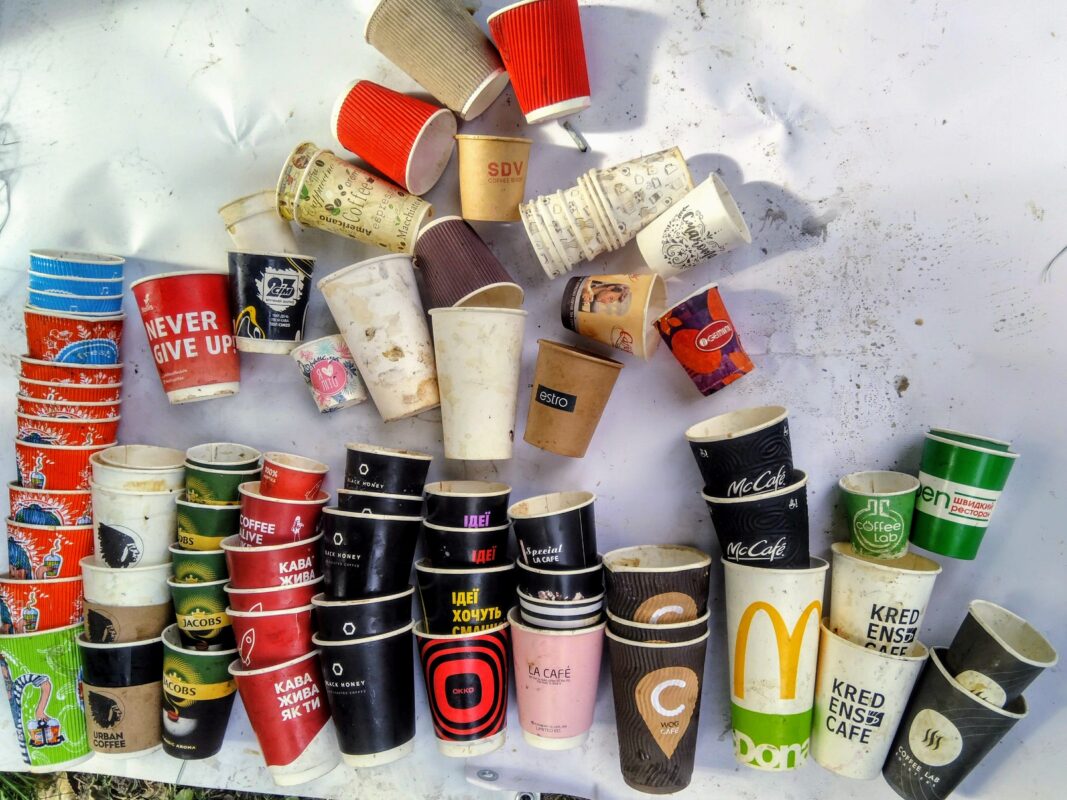“Tell us what’s in your bin, and we’ll tell you what and how much you can reduce!” Under this slogan, representatives of our organization Zero Waste Lviv went out last September to investigate the contents of rubbish bins in one of Lviv streets close to the city center.
You are probably wondering why we’ve decided to rummage in the garbage. Well, we did this to:
- Find out what is thrown away in the city center.
- What types of waste predominate and in what quantities they can be found.
- Is the waste in the tourist part of the city different from the waste in the residential area? If so, how different is that?
- Separate recyclables and non-recyclables.
- Join the international movement #breakfreefromplastic and represent Ukraine in the international zero mwaste arena.
- Determine which brands are most involved in littering the streets of Lviv.
Because of the last point this action got its name – Brand Audit. It took place not only in Ukraine, but all over the world under the coordination of the international organization Break Free from Plastic. The purpose of the brand audit is to check what goes into municipal garbage bins and to find out what business is involved in production of this rubbish.
Location of the study: Sichovykh Striltsiv Street. It was chosen for a reason: you’ll find 7 cafes here with to-go drinks options in each of them ). Together with disposable cups you’ll always find the related products and related products: lids, stirrers, sugar sticks. We paid attention not only to the quantity of disposable tableware, but also to its condition. For example, whether the recyclables were squeezed before being thrown in the bin, or whether the cups were stacked to reduce the volume.
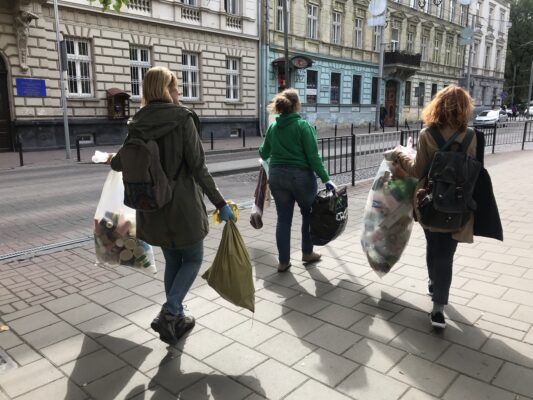
The results of the rubbish bins inspection
The results of the inspection are as follows: PET bottles and cans were rarely squeezed, and cups were often thrown away without removing the lid. Thus, one street bin fills up very quickly. During the academic year (Ivan Franko Lviv National University is located nearby), the bins should be emptied at least three times a day. And these are additional funds that the city spends on “improvements”.
⅕ of the garbage we took from the bins were particularly disposable cups. They filled half a 120-liter garbage bag. For comparison – we collected a full 120-liter bag of PET bottles and paper, while the volume of glass was about 50 liters.
You can see in the table below how many and what disposable cups we found
| Aroma kava | 14 | La Café | 4 |
| Urban Coffee | 5 | Open | 2 |
| Black Honey | 5 | Франсуа | 1 |
| Rocket Espresso | 6 | No Name | 20 |
| Jacobs | 6 | 23|7 | 1 |
| OKKO | 4 | Mollis | 1 |
| WOG | 3 | SDV | 1 |
| McDonalds | 3 | Gemini | 1 |
| Kredens Café | 2 | Estro | 1 |
In total – 80 pieces. It may seem like a trifle to you, but we’ll explain why it’s not:
- This number of cups was collected within 5 hours (because at 6 am these containers had already been emptied, and we arrived at 11 am).
- We conducted the Brand Audit on Saturday, when the university is closed, there are no classes, and it is less crowded than on weekdays.
- Sichovykh Striltsiv Street is generally not very busy, because it is not located in the very center of Lviv, and the crowd flow here is usually not very large, but stable.
With this in mind, we can say with confidence that on weekdays, several hundred cups a day will end up in the rubbish bins, even with the least load, as was the case when we conducted the Brand Audit.
And in order to clearly show the shocking amount of rubbish which is thoughtlessly being thrown away we’ll show you these 2 photos below:
In the first photo you see cups that were just thrown in the bin. In the second you can see the same cups if you stack them.
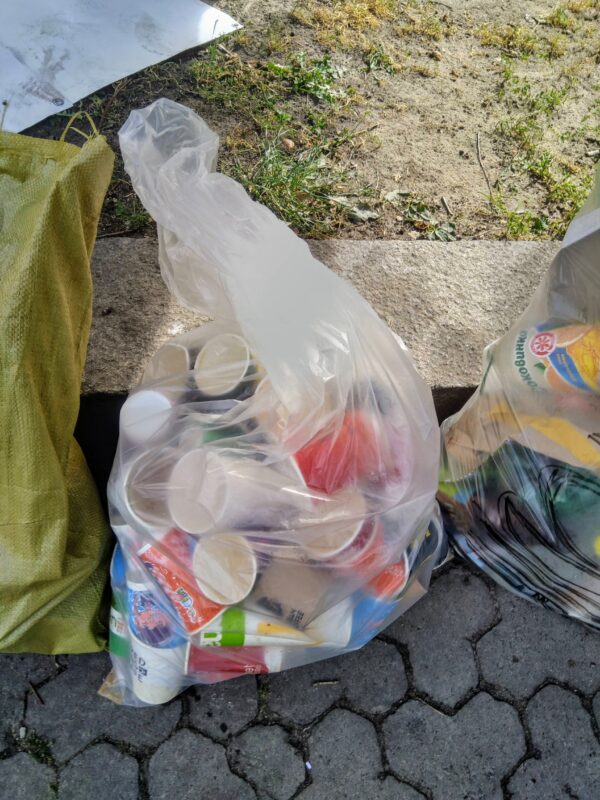
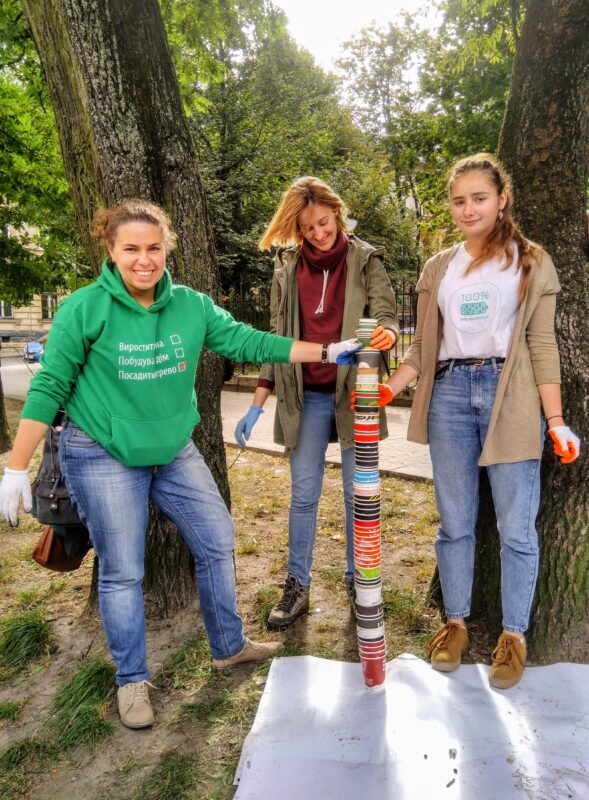
Impressive changes, right? And this approach applies to all types of waste and recyclable materials that can be reduced. Therefore, before disposing of waste in a container, be sure to squeeze a PET bottle, unfold cardboard boxes and flatten aluminum cans.
What’s wrong with disposable cups?
Just in case, we’d like to remind you what is wrong with disposable cups, except that they take up a lot of space in the bin. We collected the main features for you:
- A paper cup is not entirely made of paper – it has a thin layer of polyethylene that prevents prevents hot beverage spills on your hands and clothes, so it is not waste paper. And only one plant in Ukraine recycles such type of packaging – in the town of Zmiiv, in the Kharkiv region. And if you calculate the logistics to the plant and add the required number of tons (yes, tons) of cups to get them there, it will take more than one month and more than one thousand hryvnias, not to mention the carbon footprint.
- In a year, one person who is used to take coffee to go in disposable cups creates about 10 kg of garbage.
- One to-go coffee shop generates 500-700 discarded disposable cups a day, as well as lids and straws that cannot be recycled. On a global scale, these figures are shocking – 5 billion cups a year! That is, every minute about 1 million paper cups gets into a trash bin worldwide.
- Conservation of resources: disposable cups cannot be made from recycled raw materials, so a new tree will be cut for each new cup.
At this stage, you’ve probably lost your heart, but please don’t be sad. Because there are alternatives, there are even several of them. And we will try to implement most of them with the help of our new project ZeroCup.
And our favorite and eco-conscious reason is not to buy drinks in disposable cups, but to choose reusable ones instead. In the long run, this investment pays off – because it is closely linked to a discount on coffee. When you decide to buy your own cup for a coffee to go, the price will often vary between 250-400 UAH. If you take coffee in your cup 2 times a week, and you will have a discount of 2 UAH each time, this amount then will be 192 hryvnias per year, that is, the price of the cup will pay off in a maximum of 1.5-2 years, and then you’ll have net savings.
That’s why we urge you to use reusable cups for drinks to go, or to enjoy a drink in the restaurant inside – so you can take your time to feel the taste of your favorite coffee or tea and reduce reduce landfill waste.
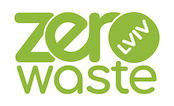

 UA
UA